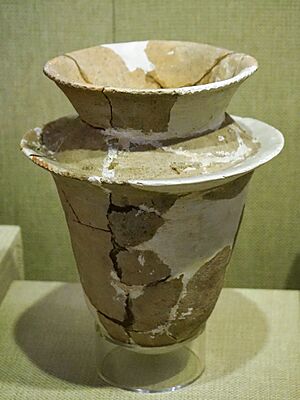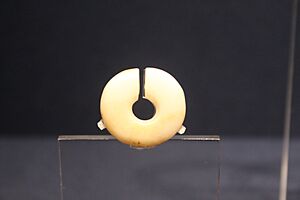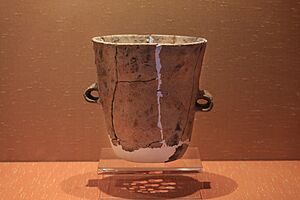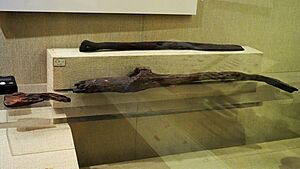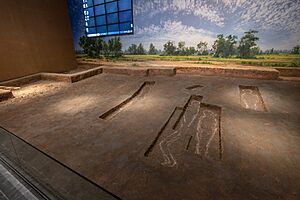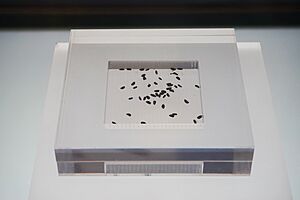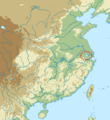Majiabang culture facts for kids
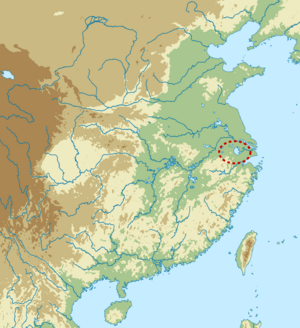 |
|||||||||
| Alternative names | Ma-chia-pang culture | ||||||||
|---|---|---|---|---|---|---|---|---|---|
| Geographical range | Zhejiang, China | ||||||||
| Period | Neolithic China | ||||||||
| Dates | 5000–3350 BC | ||||||||
| Major sites | Weidun Site | ||||||||
| Followed by | Liangzhu culture | ||||||||
| Chinese name | |||||||||
| Traditional Chinese | 馬家浜文化 | ||||||||
| Simplified Chinese | 马家浜文化 | ||||||||
|
|||||||||
The Majiabang culture (also called Ma-chia-pang) was an ancient group of people who lived during the Neolithic period. This means they lived in the Stone Age, when people started farming and building settled villages. They lived in the Yangtze River Delta region of China, especially around Lake Tai near what is now Shanghai.
This culture existed from about 5000 BC to 3300 BC. It spread across southern Jiangsu and Zhejiang provinces. Another culture, the Hemudu culture, lived at the same time in Zhejiang, south of Hangzhou Bay. Later, the Majiabang culture developed into the Songze culture and then the Liangzhu culture.
Archaeologists believe the Majiabang culture was important for early farming, fishing, and hunting in China. They were especially good at growing rice. Farming was a very important way for them to get food and live.
Contents
Life in the Majiabang Culture
The Majiabang people were skilled farmers. They grew a lot of rice. At sites like Caoxieshan and Chuodun, archaeologists found ancient paddy fields. This shows how central rice farming was to their lives.
They also raised animals. Evidence from their sites shows they kept pigs. However, they still hunted wild animals like Sika deer and Siberian roe deer. This means they didn't rely only on farming for food. The Majiabang people also made beautiful jade ornaments.
At the Songze site in Shanghai, archaeologists found the skeleton of a man from the Majiabang era. He was about 25-30 years old and is one of the earliest people found in that area.
Majiabang and Other Cultures
At first, experts thought sites in northern Jiangsu were part of the Majiabang culture. They called this the Qingliangang culture. But later, they realized the northern sites belonged to the Dawenkou culture. So, the southern sites were then named the Majiabang culture.
Some scholars think the Hemudu culture was a separate group that lived at the same time as Majiabang. They believe these two cultures shared ideas and knowledge. Other scholars think Hemudu might have been a part of the Majiabang traditions.
Ancient Environment
During the time of the Majiabang culture, the climate was different from today. It had more rain and higher average temperatures. Around 7000 to 6500 years ago, the area received 1500 to 2000 millimeters of rain each year. The average temperature was 15 to 18 degrees Celsius.
After that, the temperature dropped a bit around 6000 years ago. Then it rose slightly around 5500 years ago. Since about 5300 years ago, the temperature has slowly become cooler. These changes are similar to climate shifts seen in other parts of the world during that time.
Important Archaeological Sites
The Weidun Site is a very important place where Majiabang culture was discovered. It was found in 1985 in Changzhou, Jiangsu Province. Archaeologists found many artifacts and about 38 burials there.
The ground at Weidun has layers, almost 2 meters deep. These layers show different periods of time. Thirty-three of the burials belonged to the Majiabang culture. Only seven of these burials had objects buried with them. For example, in tomb M127, archaeologists found a male skeleton lying on his back, facing east. With him were stone adzes, spindle whorls, and ceramic bowls.
Majiabang Artifacts
The Majiabang people were skilled at making things from different materials. They used jade and pottery to create objects for various purposes. These ancient items show their beliefs and how they lived. They also tell us about a person's social status in the Neolithic period.
Jade Ornaments
The Majiabang people made jade into beautiful ornaments. At the Weidun Site, archaeologists found several jade objects. These included earrings, pendants, small tubes, and other decorations. They used local jade to make items like penannular (almost complete circle) rings and semi-annular (half-circle) discs.
Pottery Creations
Most of the pottery from the Majiabang culture was made by hand. Early pottery was made from mud found near riverbanks. People used firewood and flat ground to bake their pottery. Later, they started adding a red coating to their pottery.
They made many types of pottery for daily use, such as pots, jars, and bowls. These were important for cooking, drinking, and even for special ceremonies. Pottery objects were also sometimes buried with people in their tombs.
At the Weidun Site, many pottery items were found. These included `fu`-cauldrons, `guan`-pots, `ding`-tripods, `dou`-stemmed plates, `bo`-bowls, and `pen`-basins. Most were made of fine clay, and some had shell or sand mixed in.
Types of Pottery Vessels
- Fu-cauldron: These cooking pots came in three main types. Some had wide rims and flared necks, while others had narrower necks. Some even had flower patterns around the rim.
- Guan-pot: There were five types of `guan`-pots, often found as broken pieces. They varied in shape, from round shoulders and narrow necks to slim bodies and small flat bottoms. Some had handles like a cow's nose.
- Ding-tripod: These pots stood on three legs. They came in two main types: one looked like a cauldron, and the other looked more like a pot. Their legs could be thin, wide, or long.
- Dou-stemmed plate: This dish had two parts: a stem and a plate. The stems could be slim or chunky. The plates could be shallow or deep, with either a narrow or flared rim.
- Bo-bowl: These bowls came in two types. One had a wide, flared upper body, and the other had a narrower upper body.
- Pen-basin: These basins also had two types. One had a round belly, and the other had a more angled shape.
Tools for Daily Life
The Majiabang people used different materials to make their tools. These included stone, wood, bone, antler, and teeth. Wood was a very important material for tools.
Stone Tools
At the Weidun site, archaeologists found stone tools like adzes and axes. Most of these tools were polished smooth. Adzes came in two main shapes: wide and flat, or long and thin. Axes were either flat and trapezoid-shaped or tongue-shaped.
Wooden Tools
Wood was another key material. Large wooden objects were found at Weidun. These included `scull`s (a type of oar) and `oar`s. The `scull`s were made from thick logs and were about 120 cm long. The `oar`s were flatter, half-ellipse shaped, with a handle, and shorter (70 to 90 cm long).
Bone, Antler, and Teeth Tools
Tools made from bone, antler, and teeth were also found at Weidun. These included bone `degree`s and knives. Antler was used to make shoe-shaped tools, arrowheads, awls (for piercing holes), needles, spears, and tubes.
Burial Customs
Burial customs are an important part of understanding a culture. They show what people believed about life after death and how they made things. The Majiabang people believed that after death, a person's spirit could return to their home. This is why their graves are often found near their settlements.
Around 6500 years ago, people didn't have special burial areas. They were buried near their homes, lying on their side with bent limbs and their heads facing east. The male skeleton found at Weidun (in grave M127) was buried this way, lying at a 20-degree angle and facing east.
About 500 years later, their burial customs changed. They started burying people in separate pits within a shared burial area. In these later burials, people were laid flat on their stomachs, stretched out, with their heads facing north and feet facing south.
Rice Farming in Majiabang
Growing rice was one of the most important things the Majiabang culture did. Experts believe that rice farming in the Yangtze River Delta began early in the Majiabang period. It grew quickly, even though people still relied on hunting, fishing, and gathering.
This is proven by what was found in ancient paddy fields. Luojiajiao, a site from 5300 to 4900 BC, is one of the earliest. At this site, archaeologists found hundreds of burnt rice husks and grains. Studies showed that half were from cultivated rice, and half were from wild rice.
At other sites from later periods (5000 to 4300 BC and 4300 to 3500 BC), even more rice remains were found. This shows that rice farming became more and more important over time, while gathering wild plants became less common.
Images for kids


